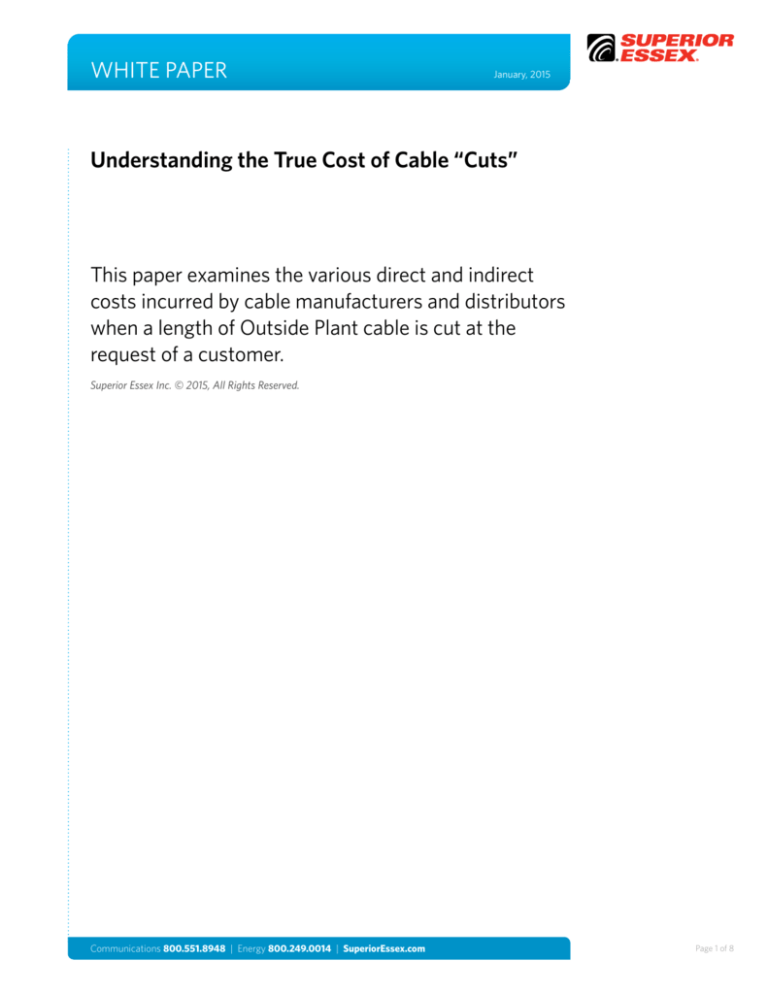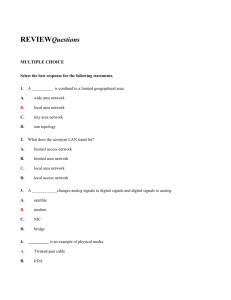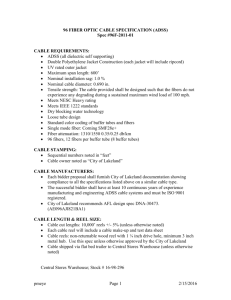
WHITE PAPER
January, 2015
Understanding the True Cost of Cable “Cuts”
This paper examines the various direct and indirect
costs incurred by cable manufacturers and distributors
when a length of Outside Plant cable is cut at the
request of a customer.
Superior Essex Inc. © 2015, All Rights Reserved.
Communications 800.551.8948 | Energy 800.249.0014 | SuperiorEssex.com
Page 1 of 8
WHITE PAPER
January, 2015
Overview
Many buyers of Outside Plant (OSP) copper and fiber cable products are surprised by what they
perceive to be a high price for the simple task of cutting a piece of cable. Certainly, (the logic goes)
the act of unwinding a predetermined length of cable and cutting it into two pieces is a straightforward
job that could not justify the additional $100+ fee often charged by distributors and manufacturers.
This paper examines all of the costs that are incurred by the manufacturer or a stocking distributor
when a length of cable is cut for the purpose of selling a short length and holding the rest of the
reel for a future customer. What will surprise many OSP cable buyers is that the total cost (to the
manufacturer or distributor) of cutting a cable piece is usually higher than the fee (the “cut charge”)
to the customer.
Background
When a buyer of OSP cable requests that a piece of cable be cut from a longer cable length, the
manufacturer (or distributor) will incur two direct costs prior to shipping the cut length. A labor cost
will be incurred from loading the inventory cable onto a re-spooling machine, paying off the length of
cable onto a second reel, cutting the cable to the appropriate length, and re-spooling the remaining
portion of the first reel of cable onto an appropriately sized reel and returning it back to inventory.
The cost of the reel used for the cut length of cable represents the second direct cost.
Cable scrap cost is one of the indirect costs incurred when a cable is cut to a specified length.
Cable manufacturing, in contrast to most other manufacturing businesses, is inherently focused
on long length production. Any length of cable that is too short for a customer’s application ends up
as scrap. For cables designed for indoor use, relatively short lengths are entirely usable. For example,
cables used to make wire assemblies, patch cords, HDMI cables, and virtually all consumer cable
products are usable in lengths less than 100 feet. In contrast, OSP cable products are typically used
for applications requiring longer lengths, and these cable types are often determined to be scrap
in lengths less than 500 feet. And for some cable designs a length of 1,500 feet is categorized as scrap.
“Short-length discounting” and inventory holding cost represent the second type of indirect cost
associated with cable cutting. When a master reel of cable is cut the remaining length will generally
fall into one of three groupings:
• Long enough for most customer applications
• Short enough to be classified as scrap
• Shorter than most customers want, but applicable for special applications
This third grouping of cable remnants ends up as inventory that ties-up working capital for a long
period of time. These remnant lengths are often discounted significantly, because very few customers
are willing to purchase lengths that cannot be used for most project distances. However in many
cases, these cables are never sold and are scrapped.
Communications 800.551.8948 | Energy 800.249.0014 | SuperiorEssex.com
Page 2 of 8
WHITE PAPER
January, 2015
Labor Costs of Cutting
The labor cost associated with cutting and re-spooling a piece of OSP cable varies with the length
of the requested cut, size of the cable, number of cuts from a payoff reel, and whether the balance
has to be re-spooled onto a smaller reel or returned to inventory on the same reel.
The actual cable cutting takes very little time. However, in order to make the cut, a series
of activities occur:
1.
Locate the cable to be cut, bring it to the cut line, secure the reel in the payoff, untie the cable
end, and thread the cable through the cut line.
2.
Locate the correct size/empty cut reel, bring it to the cut line, secure it in the take-up, thread
the cable through the start hole, and secure the end of the cable to the outside flange of the reel.
3.
Re-spool the cable until the location to be cut is accessible.
4. Cut the cable to the desired length.
5.
Run the last few feet on to the take-up reel, secure the end of the cable, remove the take-up
reel from the take-up.
6. If there is another cut from the pay-off reel, repeat steps 2 through 5 for the second cut.
7.
If there is no other cut from the pay-off reel, pull the last few feet back onto the payoff reel,
secure the cable end, and remove the reel from the take-up.
8. Move the payoff reel back to inventory.
9. Move the cut length to the shipping dock for loading.
10. Complete all paperwork.
On average, the direct labor cost per cut for OSP copper cable is $48. OSP fiber cable tends to have
much longer cut lengths than OSP copper cable, and customers expect a perfect wind. Consequently,
much more time is spent re-spooling an OSP fiber cable reel, and this leads to a higher average direct
labor cost per cut of $65.
Picture of cable being re-spooled from large reel to smaller reel
Communications 800.551.8948 | Energy 800.249.0014 | SuperiorEssex.com
Page 3 of 8
WHITE PAPER
January, 2015
Reel Costs
With very few exceptions, a cut cable length is required to be re-spooled onto a new reel. For OSP
cable products, the reel cost ranges from $35 to $500. For small diameter cables (less than 2”)
the cost of the reel is relatively low for short lengths and increases proportionally as the cut length
increases. However, for large diameter cables, the drum size of the reel typically needs to be large
to accommodate a large bending radius. Consequently, large diameter cables usually require an
expensive reel even if the length of cable being ordered or shipped is relatively short.
Graph #1 shows the cost of wooden reels for five (5) different cable sizes, as a function of cable length.
Graph #1
Scrap Costs
Once a master length of cable is cut for a customer order, it is likely that it will be cut from again for a
subsequent cut-to-length order. At some point, perhaps even after the first cut is made, the remaining
length of cable will be categorized as scrap, and the cable will be recycled (copper cable) or disposed
of (fiber cable). On average, about 60% of the production cost of OSP copper cable is recoverable due
to the high content of copper and other metals. That is, the amount of money lost for a scrapped OSP
copper cable is about 40% of the cost of making the cable.
For fiber cables, the loss of scrap is 100%. There is no cost recovery obtained scrapping a length of
fiber cable even though the plastics and steel used to make the cable are sometimes recyclable. That
is, the manufacturer or distributor will not typically receive any compensation for sending a fiber cable
to a recycler.
Communications 800.551.8948 | Energy 800.249.0014 | SuperiorEssex.com
Page 4 of 8
WHITE PAPER
January, 2015
To understand the cost of scrap due to cut-to-length orders, we will examine OSP copper and OSP
fiber cable separately.
In the case of OSP copper cable, manufacturers usually produce master lengths ranging between
1,000 and 10,000 feet, depending on the cable type. A cable shorter than 300 feet would normally
be categorized as scrap. The length of the final remnant piece depends on the lengths of all of the
previous cut lengths and it follows a normal distribution curve. Consequently, the average length of
a scrap remnant is assumed to be the midpoint of 300 feet and 0 feet, or 150 feet for this analysis.
Assuming 60% cost recovery from recycling the average 150 feet remnant, the cost of the scrap
would be equivalent to the production cost of 60 feet of cable. For a small 50-pair cable, the scrap
cost to the manufacturer would typically be about $50. For a large 1200-pair cable, the scrap cost to
the manufacturer would typically be about $1,000. These costs would be higher for a distributor as
the cable cost additionally includes the cost markup from the manufacturer.
From experience at Superior Essex, a master length of cable will be cut an average of 3 times (for cutto-length orders) before the remaining length is categorized as potential scrap. To arrive at a scrap
cost per cut length, the average number of cuts should be divided into the average cost of scrap per
master length.
• Using the above example of a 50-pair copper cable, the average cost of scrap per cut is $50/3 = $17
• Using the above example of a 1200-pair copper cable, the average cost of scrap per cut is
$1,000/3 = $333
Graph #2 shows a Superior Essex estimate of net scrap cost to the manufacturer, as a function of OSP
copper pair count, with the assumption of an average remnant length of 150 feet.
Graph #2
OSP fiber cable is generally smaller in diameter than OSP copper cable. As a result, longer lengths of
OSP fiber cable can fit onto large reels. Consequently, the lengths of fiber cable categorized as scrap
usually represent a smaller percentage of the original master length than with OSP copper. However, the
scrap recovery for OSP fiber cable is usually zero, negating the advantage of longer master cable lengths.
Communications 800.551.8948 | Energy 800.249.0014 | SuperiorEssex.com
Page 5 of 8
WHITE PAPER
January, 2015
OSP fiber cable in short lengths also has less commercial value than OSP copper cable in equivalent short
lengths. This is because OSP fiber cable tends to be used in longer distances than OSP copper cable.
OSP fiber cable lengths shorter than 1,000 feet are generally categorized as scrap. As is the case for
OSP copper, the length of the final remnant OSP fiber cable piece depends on the lengths of all of the
previous cut lengths and it follows a normal distribution curve. Consequently, the average length of a
scrap remnant is assumed to be the midpoint of 1,000 feet and 0 feet, or 500 feet for this analysis.
Because there is rarely any scrap recovery, the act of scrapping 500 feet remnants is equivalent to
the total manufacturing cost of the cable. For singlemode 24-fiber cable, the scrap cost of 500 feet of
cable would typically be about $90. For a singlemode 288-fiber cable, the scrap cost of 500 feet of
cable would typically be about $650. These costs would be higher for a distributor as the cable cost
additionally includes the cost markup from the manufacturer.
From Superior Essex’s experience, a master length of OSP fiber cable will be cut an average of 4 times
(for cut-to-length orders) before the remaining length is categorized as scrap. To arrive at a scrap cost per
cut length, the average number of cuts should be divided into the average cost of scrap per master length.
• Using the above example of a 24-fiber cable, the average cost of scrap per cut is $90/4 = $23
• Using the above example of a 288-fiber cable, the average cost of scrap per cut is $650/4 = $163
Graph #3 shows a Superior Essex estimate of net scrap cost to the manufacturer, as a function of OSP
fiber count, with the assumption of an average remnant length of 500 feet.
Graph #3
Short Length Discounting
Sometimes the cable remaining on the master reel is long enough to avoid being categorized as
definitively scrap, but is too short to be sold without being discounted. These types of cable remnants
are called “shorts” within the industry. Discounting a good cable, simply because it is shorter than the
typical length, is not ideal for the manufacturer. However, this outcome is much preferred over the
scenario in which the remnant piece is scrapped. Therefore, for the purpose of this analysis, we will
assume short-length discounting prevents the cost of scrapping the remnant and we will not count a
price discount as a cost. “Shorts,” however, do tend to take a long time to sell. Therefore, we will count
Communications 800.551.8948 | Energy 800.249.0014 | SuperiorEssex.com
Page 6 of 8
WHITE PAPER
January, 2015
the inventory holding cost of creating shorts due to cut-to-length orders in this analysis and we will
use an average annual turnover of 2 for these sellable “shorts.”
From Superior Essex experience, when a master reel of cable has been used to fulfill cut-to-length
customer orders, the final remnant length can eventually be sold to a customer 40% of the time.
Consequently, 60% of the time (on average) the final remnant length will be scrapped. This has
two implications.
1.
The average cost of scrap per cut (calculated previously in the “Scrap Costs” section) should
be reduced by 40%. This is because the final remnant will not end up as scrap 40% of the
time. The scrap costs calculated in the “Scrap Costs” section of this paper will be reduced
by 40% for the final cost calculations (see the “Total Cost Calculations” section).
2.
The inventory holding cost for sellable “shorts” is equal to the cost of capital for the
manufacturer times the value of the shorts held in inventory. Using the same copper cable
examples from above (50-pair cable and 1200-pair cable) assuming an annual cost of capital
of 10%, and assuming an average of 6 months longer to sell the cable than normal, the
inventory holding costs per cable cut for these two examples are:
• 150 feet of 50-pair copper cable: $125 x 10% x ½ year/ 3 cuts = $2.08
• 150 feet of 1,200-pair copper cable: $2,500 x 10% x ½ year/ 3 cuts = $41.67
Similarly, we can calculate the inventory holding costs for OSP fiber cable remnants. Using the
previously detailed costs for 2 fiber cable types (24-fiber and 288-fiber), using an annual cost
of capital of 10%, and assuming an average of 6 months longer to sell the cable than normal,
the inventory holding costs per cable cut for these two examples are:
• 500 feet of 24-fiber OSP cable: $90 x 10% x ½ year/ 4 cuts = $1.13
• 500 feet of 288-fiber OSP cable: $650 x 10% x ½ year/ 4 cuts = $8.13
Total Cost Calculations
The total cost of a cable “cut” is the sum of the costs from labor, additional wooden reel, net scrap
cost (properly adjusted for sales of “shorts”), and inventory holding cost of a remnant which is not
scrapped, with shared costs properly allocated to the total number of cuts from a master length.
The cost per cut is a function of cable size, cable cut length, and cable type. It is apparent from the
individual cost breakdowns detailed in this paper that cable size is the most important determinant
of true cutting cost, but that copper cables and fiber cables need to be considered separately. Cut
lengths less than 1500 feet are the most common, and this summary cost analysis assumes cut
lengths of 1,000 feet to simplify the dimensions of the cost analysis.
Graph #4 shows the total cost to the manufacturer of making a cut from a master reel, as a function
of the cable size for OSP copper cable. Total costs to the distributor would be higher due to the cost
markup of the cable from the manufacturer to the distributor.
Communications 800.551.8948 | Energy 800.249.0014 | SuperiorEssex.com
Page 7 of 8
WHITE PAPER
January, 2015
Graph #4
Graph #5 shows the total cost to the manufacturer of making a cut from a master reel, as a function
of the cable size for OSP fiber cable. Total costs to the distributor would be higher due to the cost
markup of the cable from the manufacturer to the distributor.
Graph #5
Summary
This analysis shows that the average cost to the manufacturer of cutting a customer-specified length
of cable from a master reel ranges from $102 to $439 (for typical OSP copper cable cut lengths) and
ranges from $180 to $321 (for typical OSP fiber cable cut lengths). Costs for distributors would be
higher. For both copper and fiber cable types the average cost of a cut is correlated to the diameter
and unit cost of the cable.
Communications 800.551.8948 | Energy 800.249.0014 | SuperiorEssex.com
Page 8 of 8








